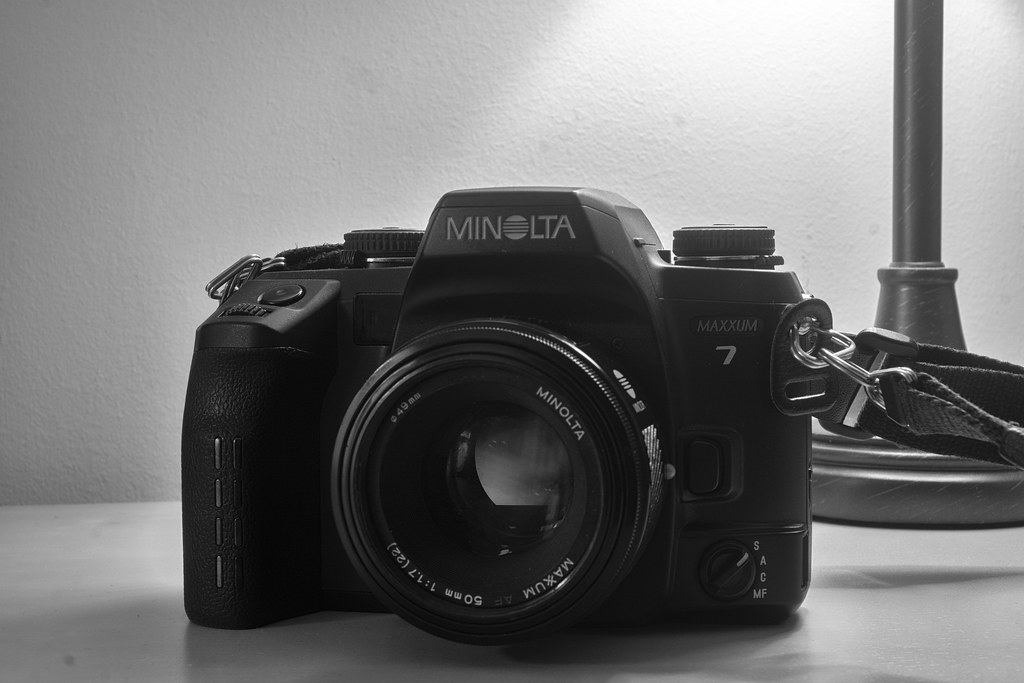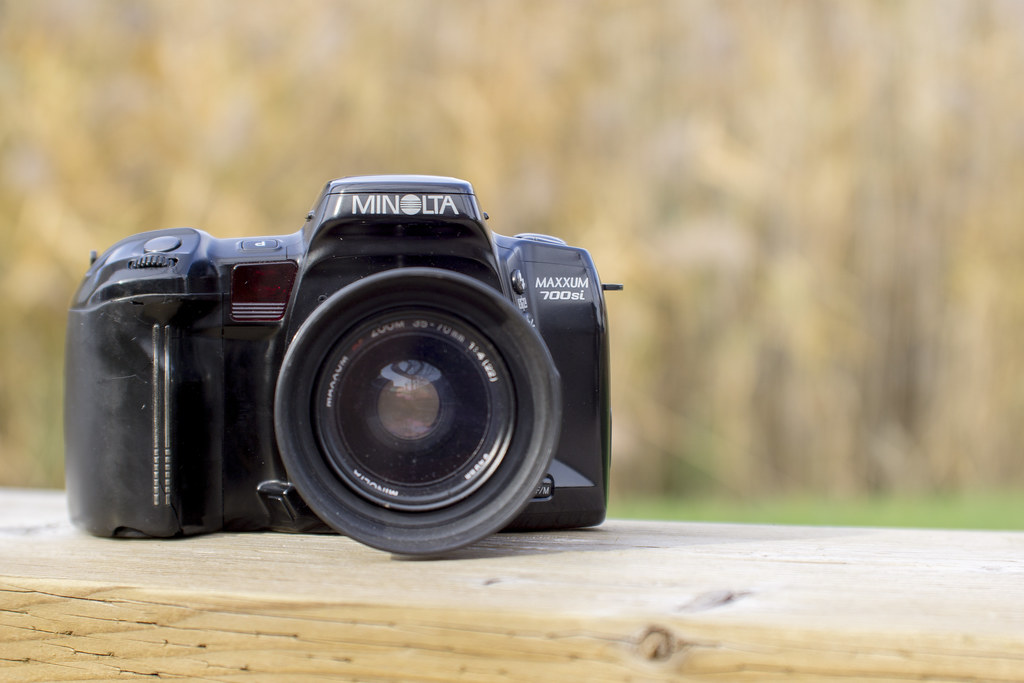Thinking back to what could have been, I remember when I first got into film photography, photography in general and happened across Minolta. The SR-T 102, Hi-Matic 7s, even the X-7a, but I wanted to make the jump to autofocus. I was in a local bargain shop and happened across an open box, the Maxxum 7. It didn’t come with a lens and was well outside my price range. And now that I know more about that shop, it was probably hot also. I ended up switching to Nikon. But here it is now, the Minolta Maxxum 7, what many online sites describe as the perfect camera for pros and amateurs, and it doesn’t just look good, it performs flawlessly! Special thanks to James McFarlane for loaning out this beauty.

Camera Specifications
Manufacturer:
Model: Maxxum 7
Alternate Names: α-7, Dynax 7
Type: Single Lens Reflex
Format: 135 (35mm), 24x36mm
Lens: Interchangeable, Minolta A-Mount
Shutter: Metal Vertical Travel Focal Plane Shutter, 30s – 1/8000s + Bulb
Meter: 14-Segment Honeycomb Pattern, SPD TTL Meter, EV0 ~ EV18 @ ASA-100, ASA-6 – ASA-6400
Autofocus: 9-Point TTL Phase-Detection System dual Cross Hair CCD sensors
Dimensions (WxHxD): 143.5×97.5×65.5mm
Weight: 575g (w/o batteries)
Power Source: 2x CR123A Batteries
Year of Manufacture: 2000-2008
Background
Founded 1929 as a joint German-Japanese firm, Minolta first appeared as a camera model in 1933. These early cameras relied on either plate or roll films; it was not until after the Second World War that Minolta produced their first 35mm camera. The SR-2 marked the entry into the SLR field in 1958, and a metered SLR, the SR-7, in 1962. Only four years later, the SR-T 101 added an open aperture through the lens metering. The most significant leap forward would happen in the 1970s with a technology-sharing agreement with Leitz, and Copal gave birth to the X-Series. The X-Series added various levels of automation to the Minolta SLR lineup. The 1970s also brought mainstream acceptance of using microprocessors in cameras, but it also got the ability to create a viable autofocus system. While both Nikon and Leitz had been working on autofocus systems since the 1960s, they were heavy beasts that required the entire system to be enclosed in the lens itself. Leitz had demonstrated an autofocus system on a heavily modified Leicaflex R4, but Konica released the first passive autofocus camera in 1977, the point-and-shoot C35 AF. Konica had worked with Honeywell to build the Visitronic system that used a pair of spaced CCD sensors that relied on visible light and a microprocessor to set the focus point. Polaroid would release a sonar-based autofocus system with their folding SLR SX-70, and Canon would produce an active autofocus system using infrared light. Pentax, Nikon and Canon would all produce autofocus SLRs through the early 1980s, but these were limited systems based on existing lens mounts and went nowhere.

When Minolta started to work on an autofocus system, the director of research and development, Icharo Yoshima, wanted a system that used a brand new lens mount and the motor to drive the focusing mechanisms to be in the camera body rather than the lens to keep the costs low. But Minolta did more than build a whole new lens mount; they also radically departed from standard camera designs of the era. When the Maxxum 7000 hit the market in 1985, space-age was the only word to describe the camera. The angular body did away with all physical controls; buttons controlled every function, and screens displayed feedback. The new system also included twelve lenses initially, with five zoom lenses and the rest primes from 24 to 300mm. Aimed at the prosumer market segment, the camera featured a centre-weighted meter and an autofocus system that used visible light being read by a pair of CCD sensors. The system looked suspiciously like the same one developed by Honeywell. The initial success would see Minolta release a second generation of their A-Mount cameras; in 1988, the new 7000i arrived. Gone were the boxy angles of the 7000; instead, German industrial designer Hans Muth smoothed down the edges for a sleeker look and feel. The autofocus system added a third CCD sensor for improved accuracy with six selectable focusing points. The meter also took the reading off the selected focus point. The 7000 i would take dedicated solid-state cards from the Minolta Creative Expansion Cards to expand the camera’s capabilities. It would be in the third generation, the 7xi. The automatic zoom function is one of the more unique features of the xi-series. The camera would set both the focus and the zoom based on the ideal conditions, providing you have the correct lens attached. These features were even more enhanced with the Creative Expansion Cards. Honeywell launched and won a lawsuit in 1991 against Minolta for copyright infringement with Minolta’s early autofocus system.

As a result of the lawsuit, Minolta would rethink their autofocus system, and with their fourth generation release, the 700si in 1993, a new phase detection system was introduced. The new system was far more accurate and faster than the previous systems. The new camera maintained the Expansion Card system, but most of the features added by the cards were already standard on the 700si. The 700si also added some pretty standard features on Minolta SLRs today: the new proprietary hot shoe and the eye-start system. The Eye-Start system would use a pair of sensors, one on the camera grip and a detector on the viewfinder; if the photographer were holding the camera and putting it up to their eye, the system would start, meter and focus. One interesting side-note: in 1993, Minolta released the 600si Classic; while part of the fourth generation and shared many of the same features as the 700si, it removed almost all the buttons and all the menus, going instead with physical dials and switches to control all the camera functions. While the 600si did not do well during its production period, the design influenced the fifth-generation Maxxum 7. Released in 2000, the ‘7 proved to be a solid machine; the exterior of the camera, based on the professional Maxxum 9, offered a sleek and ergonomic package with almost all the same features of the ‘9 but with some key differences. The first is the autofocus module with fourteen focus points and a highly accurate double-cross sensor at the centre point. The ‘7 only topped out at 1/8000s but did have full SSM lens support; it also featured an LCD screen on the film door that allowed for easy-to-read menus and made setting up custom modes a breeze. Production of the ‘7 ceased in 2008, but only after a digital version of the Konica-Minolta 7D was released in 2004.




Impressions
First off, the camera feels amazing in hand, even without a grip the whole experience is perfectly balanced. And that would go with the 50/1.7 and the 35-70/4 zoom. There is a bit of off-balance feel with the longer 70-210/4 “beer can” but nothing overly problematic. The grip is big, and the sensors in it allow the camera to jump to life as soon as you pick it up, there’s also an eye-start option as well. A feature I’m not 100% fond of, but thankfully there’s a switch to turn it on and off. Just make sure you don’t confuse the on/off switch for powering the camera with the eye-start. Thankfully the switches are two different sizes, and in different positions, but at a quick glance, they look very much the same. I know I was confused at first. The rest of the controls are very well laid out, with all functions being controlled by a physical switch rather than hunting through menus. The addition of a big LCD screen at the back which shows exposure details, focus points, camera mode, and other important information is a nice touch. The shutter sound is also nice. I would often switch my first digital camera (DiMAGE Z2) to sound like the Maxxum 7 just for that sound.




Experiences
Just as the camera feels amazing in hand it, also offers a fantastic experience when out in the field. The autofocus is fast and accurate, with a meter to match. The Maxxum 7 offers far more focus points than I initially thought, more than even my F5. And the selector option on the back is clear, and the points light up in red in the viewfinder. The viewfinder is bright and offers everything I need to know right there. The back LCD screen mirrors that so you don’t have to keep your eye in the viewfinder if you’re using a tripod, plus it automatically aligns to the orientation of the camera. And even though the lenses are older models, they work super fast on the Maxxum 7, a nice touch as they are all rather leisurely on the old 7000. Having never shot with one before, I found myself right at home with the camera, everything well laid out and within reach. The eye-start was a bit finicky but having a dedicated switch to turn the feature on and off was perfect.




Optics
One of the best parts about the Maxxum 7 is the ability to use all the A-Mount lenses from both Minolta and Sony, even the modern full-frame lenses offered by Sony. While earlier lenses used an in-body focus motor, the newer SSM lenses had a lens-based super-sonic motor and could only work on the unique Minolta cameras; even the Maxxum 9 required an update to make SSM lenses work perfectly. The native ability gives the ‘7 an edge, but you also have to watch out for the Sony lenses as some are designed for crop-sensor digital bodies; while they will still work, in some cases, you do have to watch out for vignetting. The Maxxum 7 shipped with the Minolta Zoom AF 24-105mm 1:3.5-4.5 D as the kit lens; this is a step up from the Zoom AF 28-100mm but is still a kit lens. While there are some faults with the 24-105, it is an okay lens and a good match for the ‘7. But the real power with the older prime lenses is that a good three-lens kit is the 24mm f/2.8, 50mm f/1.4, and the 100mm f/2.8 MACRO. A good zoom lens is the 28-135mm f/4-4.5 “Secret Handshake”, but you probably will want to add the vertical grip to help balance things out.




The Lowdown
Like all cameras from the mid-1990s, the Maxxum 7 does require a specialised battery in the form of two CR123a lithium batteries. So if you are taking the camera on an extended trip, a few spares might be in order. Prices range online between 200-500 dollars which are not bad for a camera such as the Maxxum 7, making it easily accessible to many photographers looking to update their Minolta AF system to something modern in the professional range. And yes, after using the camera I realised that I would have been thrilled with the Maxxum 7 had things been different. It’s not saying I’m not happy with my Nikon system; I’m saying I would be just as happy with a Maxxum system as I am with my Nikon system. That being said, if one were offered to me for the right price, I would snag it up without a second thought. That said, since writing this review, I happened across a Maxxum 9 and snapped it up with only a few day’s thought.
Further Reading
Don’t just take my word on the Maxxum 7; you can check out the reviews by other awesome camera reviewers!
35mmc – Minolta Dynax 7 Review
Casual Photophile – The Minolta A-7 is the perfect film SLR for shooters who want it all
Earth, Sun, Film – VMLP28: The Minolta Maxxum 7 – I’m pretty sure Picard Has One.
Steve Huff Photos – Back To Basics with a Minolta Maxxum 7
The Friedman Archives – Minolta Maxxum 7 Review
2 Comments